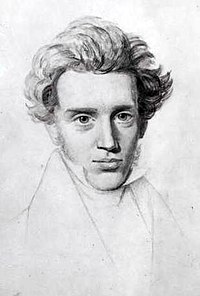Søren Kierkegaard
Søren Aabye Kierkegaard (Pípè: /ˈsɔrən ˈkɪərkəɡɑrd/ or /ˈkɪərkəɡɔr/; Àdàkọ:IPA-da) (5 May 1813 – 11 November 1855)
| Søren Aabye Kierkegaard | |
|---|---|
 Sketch of Søren Kierkegaard by Niels Christian Kierkegaard, c. 1840 | |
| Orúkọ | Søren Aabye Kierkegaard |
| Ìbí | 5 May 1813 Copenhagen, Denmark |
| Aláìsí | 11 Oṣù Kọkànlá 1855 (ọmọ ọdún 42) Copenhagen, Denmark |
| Ìgbà | 19th-century philosophy |
| Agbègbè | Western philosophy |
| Ẹ̀ka-ẹ̀kọ́ | Danish Golden Age Literary and Artistic Tradition, precursor to Continental philosophy,[1][2] Existentialism (agnostic, atheistic, Christian), Postmodernism, Post-structuralism, Existential psychology, Absurdism, Neo-orthodoxy, and many more |
| Ìjẹlógún gangan | Religion, metaphysics, epistemology, aesthetics, ethics, psychology, philosophy of religion |
| Àròwá pàtàkì | Regarded as the father of Existentialism, angst, existential despair, Three spheres of human existence, knight of faith, infinite qualitative distinction, leap of faith |
Ìpa lórí Most philosophers after him including Auden, Barth, Binswanger, Bonhoeffer, Borges, Brandes, Brunner, Buber, Camus, de Beauvoir, Derrida, Frankl, Heidegger, Hesse, Ibsen, Jaspers, Kafka, Marcel, May, Percy, Rilke, Sartre, Shestov, Strindberg, Tillich, Unamuno, Updike, Urs von Balthasar, Welsh, Wittgenstein | |
| Ìtọwọ́bọ̀wé | |
 | Àyọkà yìí tàbí apá rẹ̀ únfẹ́ àtúnṣe sí. Ẹ le fẹ̀ jù báyìí lọ tàbí kí ẹ ṣàtúnṣe rẹ̀ lọ́nà tí yíò mu kúnrẹ́rẹ́. Ẹ ran Wikipedia lọ́wọ́ láti fẹ̀ẹ́ jù báyìí lọ. |
Itokasi
🔥 Top keywords: Ojúewé Àkọ́kọ́Wikipedia:Nípa WikipediaOgun Àgbáyé Ẹlẹ́ẹ̀kejìWikipedia:Èbúté ÀwùjọÈbúté:Àwọn ìṣẹ̀lẹ̀ ìwòyíPàtàkì:SearchWikipediaÀsà oge ṣíṣẹ́ ní ilè yorùbáỌ̀rọ̀-Orúkọ (Èdè Yorùbá)Èdè YorùbáÀṣà YorùbáÀwọn ọmọ Áfíríkà Amẹ́ríkàFáìlì:Adeniran Ogunsanya.jpgBobriskyWikipedia:Abẹ́ igiPraguePàtàkì:ÀwọnÀtúnṣeTuntunLinda IkejiWikipedia:Àyọkà pàtàkìPàtàkì:ÀwọnÀfikúnMiMọ́remí ÁjàṣoroFáwẹ̀lì YorùbáPornhubOwe YorubaÀmìọ̀rọ̀ QREre idarayaISO 8601Ògún LákáayéOrúkọ YorùbáÈdè Gẹ̀ẹ́sìIṣẹ́ Àgbẹ̀OSI modelIlẹ̀ọba Aṣọ̀kanẸ̀ka:Àwọn Àyọkà pẹ̀lú ìjúwe ṣókíÌgbéyàwóHTMLKikan Jesu mo igi agbelebuÀrokòISBN